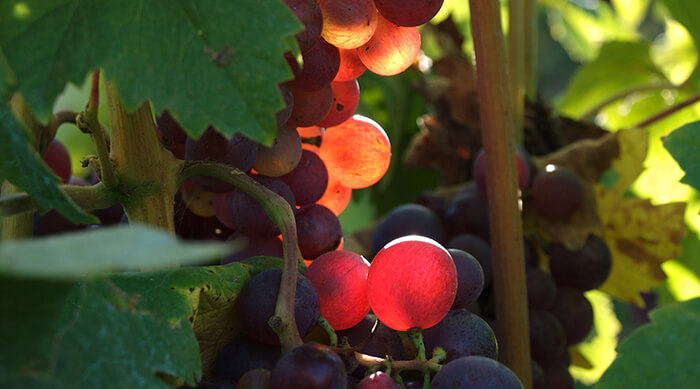Tannins are natural polyphenol compounds found in a variety of plants. The effect of tannins is multi-purpose. They let us know when those pears on the counter are juicy enough to eat and add that necessary bitterness to dark chocolate.
Tannins from tree bark have even been used to make leather. In fact, the word’s origins come from using the plant compounds to tan animal hides.
You’re not here for all of that, though. Let’s talk tannins in wine to build up your basic wine knowledge.
What are wine tannins?
Table of Contents
Wine tannins are phenolic compounds responsible for the dryness in wine. That doesn’t mean tannic wines are unpleasant. Tannins in wine are there for a reason. The winemakers wants you to taste the complexities in their wine, and that complexity often includes some bitterness.
It’s a balancing act, though. A lower-quality wine overrun by tannins may taste too sharp on your tongue. You can try aerating that tannic wine to mellow it out a bit, but it’s also possible that you’re sipping on a wine fail.
In most cases, though, high-tannin wines are meant to be that way. They’re even desirable in many of the bolder red varietals.
Where do tannins come from?
Tannins in wine come from a few different sources. They come from the grape skins themselves, of course. High-tannin wines can also get a boost of bitterness from grape seeds and stems that ferment with the wine.
Winemakers that extend that maceration process and leave the wine in contact with the grape debris for longer are typically doing that on purpose. They’re trying to increase the amount of tannins in that wine to add depths of flavor and structure.
Wines can also get tannins from oak barrels. This is especially true of red wines left to age in barrels before bottling. That’s why stainless steel barrel wines like pinot grigio or riesling are recommended for wine drinkers who don’t love that tannic aftertaste.
Tannins Impact Body & Flavor
Tannic wines have a particular mouthfeel about them. You’ve probably encountered that sensation if you’re a fan of bold reds.
How do tannins affect the taste of wine? Tannins affect the taste of wine by increasing bitterness and astrigency. The wine tasting notes on a glass of wine high in tannins will also be much more complex.
How do tannins in wine affect its body? Tannins in wine affect its body by adding more nuance to that wine. Tannic wines are typically full-bodied, bigger, and bolder.
All Wines Have Tannins
The level of tannins varies among different types of wine, but all wines have some level of tannins. Organic and natural wines have them, and white wines and rosé wines have tannins, too.
It’s not possible to find a wine completely void of tannins, because all wines start from grapes, and grapes are a natural source of tannins.
White wines just have a much lower level of tannins than red wines that sit with all of those grape bits for much longer during fermentation.
How do I know if my wine has high tannins? You know if your wine has high tannins if you pay attention to the texture of your wine. Tannic wines leave a dry feeling in your mouth. The higher the tannins, the dryer the mouthfeel.
Higher tannin wines include:
- Nebbiolo: This dry Italian wine keeps things fruity despite the tannins with notes of cherry and cranberries.
- Cabernet sauvignon: Popular cabs are known for having lots of depth. California varietals tend to be a little less intense on the tannins if you want to taste test.
- Tannat: You may not have heard of this one, but it’s the most popular grape in Uruguay. Its flavor profile is similar to more well-known malbec.
- Petite sirah: This California version of a Bordeaux wine is big, bold, and almost purple in color. Petite syrah is also high in tannins. It’s just a different grape varietal.
- Syrah: Full-bodied syrah is also full of tannins. Shiraz is essentially the same wine style. Those grapes are just grown in Australia instead of France.
- Sangiovese: Traditional Italian varietals of this wine style are savory, smoky, even astringent. The more fruit-forward styles are more mellow.
If you want just a little bit of a tannic punch, try medium-tannin grape varieties like merlot or grenache.
Wines Age Better With Tannins
You really shouldn’t age most wines that you pick up at your corner wine shop, but wines with more tannins do age better than others. The rare bottle meant for aging will improve in taste over time. The tannins might soften and reveal the winemaker’s intended flavors and mouthfeel.
Note: If you’ve been saving a bottle of good wine for a while, spend some time decanting for the sediment that’s likely settled at the bottom. That spent yeast is harmless, but your sips will be more pleasant without it.
Read Next: How Long Does Unopened Wine Last?
Tannins Aren’t Bad For You
Despite that dry mouth sensation, tannins in wine aren’t actually bad for you. When consumed in moderate amounts, tannins are actually a natural antioxidant source for wine drinkers.
What are the health benefits of drinking wine that has high tannins? The health benefits of high-tannin wines include positive effects on your cardiovascular, metabolic, and liver health.
Much like the anti-inflammatory effects of resveratrol in red wine, tannins have been linked to:
- Improved heart health: Tannins reduce oxidative stress, a cause of a variety of heart conditions. Alleviating that stress improves cardiovascular outcomes and reduces your risk of developing heart disease.
- Better gut health: Tannins can get your gut back in check thanks to their positive effects on your gut microbiota. A healthy balance in in your gut means better digestion and a stronger immune system.
- Cancer-fighting properties: Some studies show that tannins might be anticarcinogenic. That may be due to their role in reducing free radical damage to our cells or the way they fight back against inflammation. More research is needed to fully understand how that works.
Tannins can also trigger the release of serotonin, and changes in your serotonin levels may cause headaches. If you think your wine headaches are thanks to the tannins in wine, you might have a sensitivity.
(It’s probably not the sulfites in wine causing your headaches, by the way — that’s a myth!)
You don’t need to drop wine altogether if you think tannins are to blame for your head pain. Seek out white wines with a higher level of acidity, like sauvignon blanc. Low-tannin red wines like pinot noir, tempranillo, or gamay may also do the trick.
Other Foods Have Tannins Too
If you love the sound of antioxidants but are trying to cut back on wine, you can find tannins in a variety of healthy foods. In addition to obvious choices like grapes and grape juice, good sources of tannins include:
- Pomegranates
- Dark chocolate
- Black tea
- Nuts
- Rhubarb
- Squash
- Legumes
Tannins Go Great With Steak
Tannin molecules interact with the proteins in your saliva. That’s why your mouth feels dry after a glass of cabernet. That chemical reaction is also why wines high in tannins pair so well with red meat.
Tannins actually soften the fat in a cut of steak. That release of fats doesn’t just mean a juicier meat-eating experience. It softens the wine, too, pulling away some of that bitterness and astrigency.
Here’s a good rule of thumb when pairing wines: The leaner the meat, the lighter the wine.
If you’re not into steak but want to mellow out a bottle of wine, fatty cheeses also pair well with big, bold reds.
Looking for your new favorite wine?
Whether you love tannins in your wine or hate ‘em, the best wine habits involve moderate wine consumption. If you’re cutting back but love your red wines, a non-alcoholic wine like Surely’s pinot noir could be a good fix.
Not interested in tannins but like the sound of non-alcoholic wine? Surely has a bright, alcohol-free sauvignon blanc that’s perfectly balanced and easy to pair.
You can have all the things with Surely wine!
Sources
- Cardioprotective and hepatoprotective effects of ellagitannins from European oak bark (Quercus petraea L.) extract in rats
- Tannins from foods to combat diseases
- Enrichment of Food With Tannin Extracts Promotes Healthy Changes in the Human Gut Microbiota
- Recent Advances in Anticancer Activities and Drug Delivery Systems of Tannins
- Serotonin and its role in headache pathogenesis and treatment
- Saliva tannin interactions




![Sugar in Wine by Type [Plus, Sugar in Winemaking]](https://dropinblog.net/34240221/files/featured/sugar-in-wine.jpg)

![Do You Refrigerate Wine? [Guide to Reds vs. Whites]](https://dropinblog.net/34240221/files/featured/do-you-refrigerate-wine.jpg)